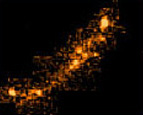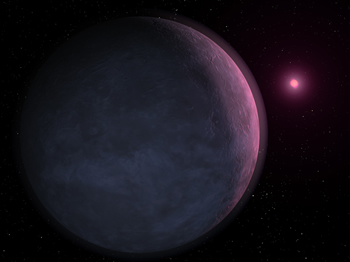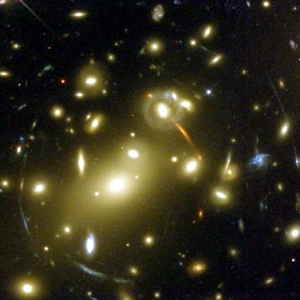Gravitational Lensing in the Galaxy Cluster Abell 2218
Click on image for full size
NASA / A. Fruchter / STScI
Gravitational Lenses - Nature's Telescope
The possibility that the path of light could be bent by the gravity of
a large object was predicted by Einstein's Theory of General
Relativity, and this effect was observed soon after the theory was
published. Because people normally think of glass or plastic lenses as
bending light, we call any massive object that bends light rays a
"gravitational lens." By measuring the amount of
bending, we can then determine the mass of whatever is doing the
bending.
In the cluster Abell 2218 (pictured here), distant blue galaxies behind the large
cluster of galaxies are "squished" into a circular shape around the
middle of the foreground cluster. By measuring the amount of
distortion in the more distant blue galaxies, we can determine the mass of the cluster. In fact, we can even
measure how much mass there is that we can't see -- this galaxy
cluster happens to have nearly 400 trillion times the sun's mass in
"dark" matter.
You might also be interested in:

A NASA Hubble Space Telescope image revealed the most distant galaxy found in the universe to date. The image the telescope took was of a galaxy cluster located 5 billion light years away. The discovered
...more
The NASA Hubble Space Telescope has recently found some awesome mirages produced by lenses in space. These lenses act as giant magnifying glasses for the Universe. A lens is produced when a large object
...more
If there are other planets in the Universe that are like Earth, then they might be places where life could survive. However, the search for planets like Earth is not easy. Most of the planets found outside
...more
In the 1960's, the United States launched some satellites to look for very high energy light, called Gamma Rays. Gamma Rays are produced whenever a nuclear bomb explodes. The satellites found many bursts
...more
During the early 1900's, which is not very long ago, astronomers were unaware that there were other galaxies outside our own Milky Way Galaxy. When they saw a small fuzzy patch in the sky through their
...more
Neutron Stars are the end point of a massive star's life. When a really massive star runs out of nuclear fuel in its core the core begins to collapse under gravity. When the core collapses the entire star
...more
Spiral galaxies may remind you of a pinwheel. They are rotating disks of mostly hydrogen gas, dust and stars. Through a telescope or binoculars, the bright nucleus of the galaxy may be visible but the
...more















